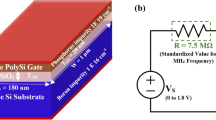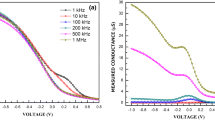Abstract
This paper proposes a unique sensor for detecting total ionizing dose (TID) on metal–oxide–semiconductor (MOS) devices. The proposed capacitive radiation sensor is based on commercial 180 nm complementary metal-oxide semiconductor (CMOS) technology. The sensor parameters of 180 nm length (L) and 20 nm oxide thickness (TOX) have been finalized based on simulation and mathematical analysis. Low and high radiation doses ranging from 100 rad to 1 Mrad are used to characterize it. The sensor's sensitivity for 0–10 krad is 20 mV/krad, 10 krad–100 krad is 3.9 mV/krad, and 100 krad–1 Mrad is 0.6 mV/krad when threshold shift is considered into account. Analysis of fixed oxide charge and interface trap charge generation due to ionizing radiation is done. Because interface traps are crucial to device performance, this device is evaluates using traps between 1 E06 cm−3 and 1 E14 cm−3 for realistic performance. Every interface trap exhibits a threshold voltage (VT) shift. Visual technology computer-aided design (TCAD) simulator was used to build, study, and evaluate a capacitive radiation sensor that might be used as a dosimeter for TID monitoring.














Similar content being viewed by others
References
Babcock, J.A.; Cressler, J.D.; Vempati, L.S.; Clark, S.D.; Jaeger, R.C.; Harame, D.L.: Ionizing radiation tolerance of high-performance SiGe HBT’s grown by UHV/CVD. IEEE Trans. Nucl. Sci. 42(6), 1558–1566 (1995)
Ge, X., et al.: Total-ionization-dose characterization of a radiation-hardened mixed-signal microcontroller SoC in 180 nm CMOS technology for nanosatellites. Microelectron. J. 87, 65–72 (2019). https://doi.org/10.1016/j.mejo.2019.04.007
Tang, A.; Kim, Y.; Chang, M.-C.F.: Logic-I/O threshold comparing -dosimeter in radiation insensitive deep-sub-micron CMOS. IEEE Trans. Nucl. Sci. 63(2), 1247–1250 (2016). https://doi.org/10.1109/TNS.2016.2528219
Kumar, M.; Ubhi, J.S.; Basra, S.; Chawla, A.; Jatana, H.S.: Total ionizing dose hardness analysis of transistors in commercial 180 nm CMOS technology. Microelectron. J. 115, 105182 (2021). https://doi.org/10.1016/j.mejo.2021.105182
Petrov, A.S.; Tapero, K.I.; Ulimov, V.N.: Influence of temperature and dose rate on the degradation of BiCMOS operational amplifiers during total ionizing dose testing. Microelectron. Reliab. 54(9), 1745–1748 (2014). https://doi.org/10.1016/j.microrel.2014.07.091
Gonella, L., et al.: Total Ionizing Dose effects in 130-nm commercial CMOS technologies for HEP experiments. Nucl. Instrum. Methods Phys. Res. Sect. Accel. Spectr. Detect. Assoc. Equip. 582(3), 750–754 (2007). https://doi.org/10.1016/j.nima.2007.07.068
Yang, X.; Wang, Y.; Du, B.; Yu, C.: Total dose radiation effects of hybrid bulk/SOI CMOS active pixel with buried channel SOI source follower. Microelectron. J. 45(4), 477–481 (2014). https://doi.org/10.1016/j.mejo.2014.02.021
Liao, X.; Liu, Y.; Xu, C.; Wang, C.; Yang, Y.: Comparison in radiation tolerance between FLR planar junction termination and positive bevel edge termination for power diodes. Microelectron. J. 128, 105565 (2022). https://doi.org/10.1016/j.mejo.2022.105565
Prinzie, J.; Simanjuntak, F.M.; Leroux, P.; Prodromakis, T.: Low-power electronic technologies for harsh radiation environments. Nat. Electron. 4(4), 4 (2021). https://doi.org/10.1038/s41928-021-00562-4
Thabayneh, K.M.: Measurement of natural radioactivity and radon exhalation rate in granite samples used in palestinian buildings. Arab. J. Sci. Eng. 38(1), 201–207 (2013). https://doi.org/10.1007/s13369-012-0391-2
**, S.; Zheng, Q.; Lu, W.; Cui, J.; Wei, Y.; Guo, Q.: Modeling of TID-induced leakage current in ultra-deep submicron SOI NMOSFETs. Microelectron. J. 102, 104829 (2020). https://doi.org/10.1016/j.mejo.2020.104829
Chen, R.M., et al.: Effects of total-ionizing-dose irradiation on SEU- and SET-induced soft errors in Bulk 40-nm sequential circuits. IEEE Trans. Nucl. Sci. 64(1), 471–476 (2017). https://doi.org/10.1109/TNS.2016.2614963
Bheesayagari, C.; Gorreta, S.; Pons-Nin, J.; Domínguez-Pumar, M.: Second order sigma-delta control of charge trap** for MOS capacitors. Microelectron. Reliab. 76–77, 635–639 (2017). https://doi.org/10.1016/j.microrel.2017.06.096
Jafari, H.; Feghhi, S.A.H.; Boorboor, S.: The effect of interface trapped charge on threshold voltage shift estimation for gamma irradiated MOS device. Radiat. Meas. 73, 69–77 (2015). https://doi.org/10.1016/j.radmeas.2014.12.008
Bonaldo, S., et al.: Total-ionizing-dose effects and low-frequency noise in 16-nm InGaAs FinFETs With HfO2/Al2O3 dielectrics. IEEE Trans. Nucl. Sci. 67(1), 210–220 (2020). https://doi.org/10.1109/TNS.2019.2957028
Park, J.-Y., et al.: Local electro-thermal annealing for repair of total ionizing dose-induced damage in gate-all-around MOSFETs. IEEE Electron Device Lett. 37(7), 843–846 (2016). https://doi.org/10.1109/LED.2016.2574341
Zalte, M.B.; Kumar, V.; Surya, S.G.; Baghini, M.S.: A solution processed amorphous InGaZnO thin-film transistor-based dosimeter for gamma-ray detection and its reliability. IEEE Sens. J. 21(9), 10667–10674 (2021). https://doi.org/10.1109/JSEN.2021.3061955
Anjankar, S. & Dhavse, R.: Comparison of total ionizing dose effect on tolerance of SCL 180 nm bulk and SOI CMOS using TCAD simulation. In Emerging Technology Trends in Electronics, Communication and Networking, R. Dhavse, V. Kumar, and S. Monteleone, Eds., in Lecture Notes in Electrical Engineering. Singapore: Springer Nature, 2023, pp. 49–62. doi: https://doi.org/10.1007/978-981-19-6737-5_5.
Anjankar, S. & Dhavse, R.: Radiation Sensor Design for Mitigation of Total Ionizing Dose Effects In Advances in VLSI and Embedded Systems, A. D. Darji, D. Joshi, A. Joshi, and R. Sheriff, (eds), in Lecture Notes in Electrical Engineering. Singapore: Springer Nature, pp. 267–279 (2023). doi: https://doi.org/10.1007/978-981-19-6780-1_21.
Li, Y.; Zhang, Y.; Cao, R.; Liu, X.; Lv, C.; Liu, J.: Redundancy design of modular DC solid-state transformer based on reliability and efficiency evaluation. CPSS Trans. Power Electron. Appl. 6(2), 115–126 (2021). https://doi.org/10.24295/CPSSTPEA.2021.00010
Liu, F., et al.: Radiation-hardened CMOS negative voltage reference for aerospace application. IEEE Trans. Nucl. Sci. 64(9), 2505–2510 (2017). https://doi.org/10.1109/TNS.2017.2733738
Garcia-Astudillo, L.A.; Entrena, L.; Lindoso, A.; Martín, H.; Martin-Holgado, P.; Garcia-Valderas, M.: Analyzing reduced precision triple modular redundancy under proton irradiation. IEEE Trans. Nucl. Sci. 69(3), 470–477 (2022). https://doi.org/10.1109/TNS.2022.3152088
Ebrahimi, M.; Miremadi, S.G.; Asadi, H.; Fazeli, M.: Low-cost scan-chain-based technique to recover multiple errors in TMR systems. IEEE Trans. Very Large Scale Integr. VLSI Syst. 21(8), 1454–1468 (2013). https://doi.org/10.1109/TVLSI.2012.2213102
González Ramírez, D.; Lalchand Khemchandani, S.; del Pino, J.; Mayor-Duarte, D.; San Miguel-Montesdeoca, M.; Mateos-Angulo, S.: Single event transients mitigation techniques for CMOS integrated VCOs. Microelectron. J. 73, 37–42 (2018). https://doi.org/10.1016/j.mejo.2018.01.005
“RESPOND Projects.” Accessed: Nov. 24, (2022). [Online]. Available: https://www.isro.gov.in/RESPONDProjects.html
“Drs2 0018sl Scl Manual|Mosfet | Spice – Documents. Accessed: May 29, (2018). [Online]. Available: https://usdocument.net/the-philosophy-of-money.html?utm_source=drs2-0018sl-scl-manual-mosfet-spice
Anjankar, S.; Dhavse, R.: Innovative leakage stabilization system for mitigation of ionizing radiation-induced effects. IEEE Sens. Lett. 7(6), 1–4 (2023). https://doi.org/10.1109/LSENS.2023.3282593
Manikanthababu, N., et al.: Ion irradiation-induced interface mixing and the charge trap profiles investigated by in situ electrical measurements in Pt/Al2O3/β-Ga2O3 MOSCAPs. IEEE Trans. Electron Devices 70(7), 3711–3717 (2023). https://doi.org/10.1109/TED.2023.3271281
Fleetwood, D.M.: Effects of bias and temperature on interface-trap annealing in MOS and linear bipolar devices. IEEE Trans. Nucl. Sci. 69(3), 587–608 (2022). https://doi.org/10.1109/TNS.2022.3147771
“A radiation-hardening Ta/Ta2O5-x/Al2O3/InGaZnO4 memristor for harsh electronics: Applied Physics Letters 113(12).” Accessed: Apr. 11, 2023. [Online]. Available: https://aip.scitation.org/doi/https://doi.org/10.1063/1.5045649
Ho, C.-H., et al.: Device process and circuit application interaction for harsh electronics: Hf–In–Zn–O thin film transistors as an example. IEEE Electron Device Lett. 38(8), 1039–1042 (2017). https://doi.org/10.1109/LED.2017.2720186
“Radiation-Tolerant p-Type SnO Thin-Film Transistors | IEEE Journals & Magazine | IEEE Xplore.” Accessed: Apr. 11, 2023. [Online]. Available: https://ieeexplore.ieee.org/document/8703828
Raval, H.N.; Rao, V.R.: OFET sensors with poly 3-hexylthiophene and pentacene as channel materials for ionizing radiation. MRS Proc. 14, 1383 (2012). https://doi.org/10.1557/opl.2012.184
Zhang, Y.; Hu-Guo, C.; Husson, D.; Higueret, S.; Lê, T.-D.; Hu, Y.: Design of a monolithic CMOS sensor for high efficiency neutron counting. Microelectron. J. 43(11), 730–736 (2012). https://doi.org/10.1016/j.mejo.2012.07.012
Campbell, K.A.; Anderson, C.M.: Phase-change memory devices with stacked Ge-chalcogenide/Sn-chalcogenide layers. Microelectron. J. 38(1), 52–59 (2007). https://doi.org/10.1016/j.mejo.2006.09.012
Pikhay, E.; Roizin, Y.; Nemirovsky, Y.: Ultra-low power consuming direct radiation sensors based on floating gate structures. J. Low Power Electron. Appl. 7(3), 20 (2017). https://doi.org/10.3390/jlpea7030020
Podlepetsky, B.I.: Total ionizing dose effects in hydrogen sensors based on MISFET. IEEE Trans. Nucl. Sci. 63(4), 2095–2105 (2016)
Mousoulis, C., et al.: Characterization of fading of a MOS-based sensor for occupational radiation dosimetry. 2016 EEE Sens. 12, 1–3 (2016). https://doi.org/10.1109/ICSENS.2016.7808645
“Cogenda | Software Downloads.” Accessed: Oct. 27, (2022). [Online]. Available: https://www.cogenda.com/article/download
Genius, “Device Simulator, Version 1.9. 0.” Reference Manual, (2008).
Anjum, A.; Vinayakprasanna, N.H.; Pradeep, T.M.; Pushpa, N.; Krishna, J.B.M.; Gnana Prakash, A.P.: A comparison of 4 MeV Proton and Co-60 gamma irradiation induced degradation in the electrical characteristics of N-channel MOSFETs. Nucl. Instrum. Methods Phys Res. Sect. B. Beam Interact. Mater. At. 379, 265–271 (2016). https://doi.org/10.1016/j.nimb.2016.04.023
Yu, T.; **, C.G.; Dong, Y.J.; Cao, D.; Zhuge, L.J.; Wu, X.M.: Temperature dependence of electrical properties for MOS capacitor with HfO2/SiO2 gate dielectric stack. Mater. Sci. Semicond. Process. 16(5), 1321–1327 (2013). https://doi.org/10.1016/j.mssp.2012.09.013
Oldham, T.R.; McLean, F.B.: Total ionizing dose effects in MOS oxides and devices. IEEE Trans. Nucl. Sci. 50(3), 483–499 (2003). https://doi.org/10.1109/TNS.2003.812927
Schwank, J.R., et al.: Correlation between Co-60 and X-ray radiation-induced charge buildup in silicon-on-insulator buried oxides. IEEE Trans. Nucl. Sci. 47(6), 2175–2182 (2000)
Ziegler, J.F.; Ziegler, M.D.; Biersack, J.P.: SRIM The stop** and range of ions in matter. Nucl. Instrum. Methods Phys. Res. Sect. B Beam. Interact. Mater. At. 268(11), 1818–1823 (2010). https://doi.org/10.1016/j.nimb.2010.02.091
Li, L., et al.: A study on ionization damage effects of anode-short MOS-controlled thyristor. IEEE Trans. Nucl. Sci. 67(9), 2062–2072 (2020). https://doi.org/10.1109/TNS.2020.3012766
Chauhan, R.K.; Chakrabarti, P.: Effect of ionizing radiation on MOS capacitors. Microelectron. J. 33(3), 197–203 (2002). https://doi.org/10.1016/S0026-2692(01)00152-5
Arshak, K.; Arshak, A.; Zleetni, S.; Korostynska, O.: Thin and thick films of metal oxides and metal phthalocyanines as gamma radiation dosimeters. IEEE Trans. Nucl. Sci. 51(5), 2250–2255 (2004). https://doi.org/10.1109/TNS.2004.834718
Sze, S. M.: VLSI Technology. McGraw-Hill, (1983).
Radiation and bias switch-induced charge dynamics in Al2O3-based metal-oxide-semiconductor structures: J. Appl. Phys. 116(17). Accessed: May 21, 2022. [Online].
Rizzo, M.; Brucoli, M.; Danzeca, S.; Masi, A.; Pineda, À.; Servera Mas, B.: An enhanced sensitivity operation mode for floating gate dosimeters. IEEE Trans. Nucl. Sci. 69(8), 1876–1883 (2022). https://doi.org/10.1109/TNS.2022.3185397
Kaymaz, A.: Ionizing radiation response of bismuth titanate-based metal-ferroelectric-semiconductor (MFS) type capacitor. Microelectron. Reliab. 133, 114546 (2022). https://doi.org/10.1016/j.microrel.2022.114546
Xuan, Y. et al. 3D MOS-capacitor-based ionizing radiation sensors In 2017 IEEE Sensors, Oct. 2017, pp. 1–3. doi: https://doi.org/10.1109/ICSENS.2017.8234043.
Author information
Authors and Affiliations
Corresponding author
Ethics declarations
Conflict of interests
The authors declare that they have no known competing financial interests or personal relationships that could have appeared to influence the work reported in this paper. The authors declare the no financial interests/personal relationships which may be considered as potential competing interests.
Rights and permissions
Springer Nature or its licensor (e.g. a society or other partner) holds exclusive rights to this article under a publishing agreement with the author(s) or other rightsholder(s); author self-archiving of the accepted manuscript version of this article is solely governed by the terms of such publishing agreement and applicable law.
About this article
Cite this article
Anjankar, S.C., Dhavse, R. Design and Optimization of MOS Capacitor based Radiation Sensor for Space Applications. Arab J Sci Eng 49, 7013–7028 (2024). https://doi.org/10.1007/s13369-023-08673-0
Received:
Accepted:
Published:
Issue Date:
DOI: https://doi.org/10.1007/s13369-023-08673-0




